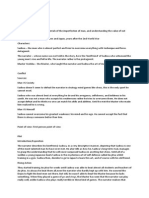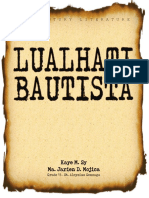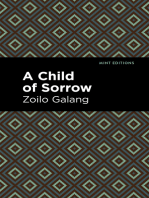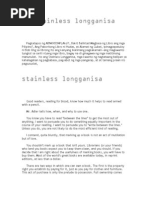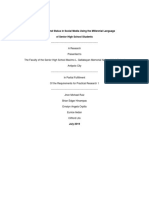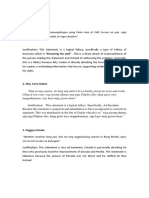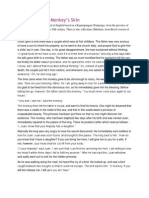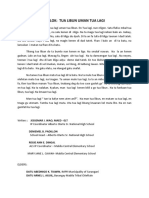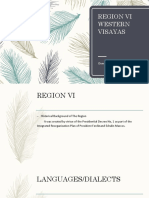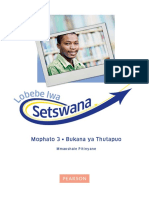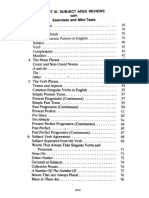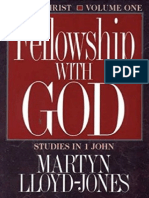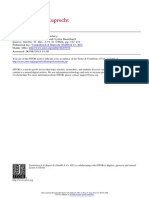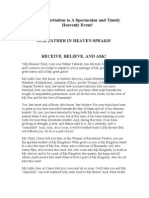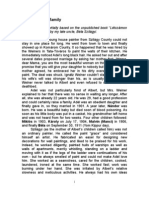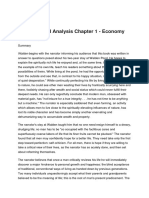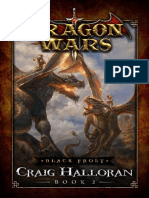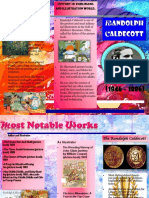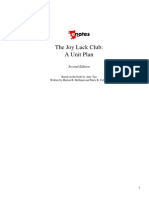Professional Documents
Culture Documents
Para Kay B
Uploaded by
FeLy DipOn63%(8)63% found this document useful (8 votes)
20K views1 pageRicky Lee's first novel, para kay b, was long overdue. The novel was initially a story of five women whose experiences of love crushed them. It's not a love story, but a tale of a man who seduces a woman.
Original Description:
Original Title
Para kay B
Copyright
© Attribution Non-Commercial (BY-NC)
Available Formats
DOCX, PDF, TXT or read online from Scribd
Share this document
Did you find this document useful?
Is this content inappropriate?
Report this DocumentRicky Lee's first novel, para kay b, was long overdue. The novel was initially a story of five women whose experiences of love crushed them. It's not a love story, but a tale of a man who seduces a woman.
Copyright:
Attribution Non-Commercial (BY-NC)
Available Formats
Download as DOCX, PDF, TXT or read online from Scribd
63%(8)63% found this document useful (8 votes)
20K views1 pagePara Kay B
Uploaded by
FeLy DipOnRicky Lee's first novel, para kay b, was long overdue. The novel was initially a story of five women whose experiences of love crushed them. It's not a love story, but a tale of a man who seduces a woman.
Copyright:
Attribution Non-Commercial (BY-NC)
Available Formats
Download as DOCX, PDF, TXT or read online from Scribd
You are on page 1of 1
Para kay B
(O Kung Paano Dinevastate Ng Pag-ibig ang 4 out of 5 sa atin)
1. Ricky Lee, perhaps one of the best-known scriptwriters in the Philippines of the last four decades, is also an important fictionist whose Palanca award-winning stories anticipated the postmodern narrative in Philippine fiction, where boundaries between genre (fiction and reportage) and realities (imagined and lived) are often blurred, if not totally wrecked. His involvement with Sigwa in the seventies also positioned him as one of the more committed writers of his generation. To say that the arrival of his first novel last year was long overdue is an understatement. Good thing, Para Kay B (O Kung Paano Dinevastate ng Pag-ibig ang 4 out of 5 sa Atin) proved worth the wait: It exhibits Lees mastery of contemporary language, mindless of how the academicians would react, and showcases his skill in creating memorable individuals, breathing ordinary yet defamiliarizing lives. At first, we might be deceived that we were given stereotypical characters and worn-out scenarios, but a little later we would feel comfortable that Lee knew what he was doing and that they were all part of the books major scheme. 2. The novel was initially a story of five women whose experiences of love crushed them differently, save for one, as the title suggests: Irene, who had a photographic memory, could not forget the promise of love she was given when she was very young, only to find out years later that she was not even remembered by the man in her past; Sandra, who fell in reciprocated love with her own brother, only to cause his lifelong suffering in the end; Erica, who came from a community called Maldiaga where love was unheard of, left home wanting a taste of love, only to realize that she was not really capable of loving someone; Ester, a widow raising a sexually active gay son, finally admitted to herself that it was her female house helper and friend whom she really loved all her life; and finally, Bessie, the promiscous lover who seduced Lucas, who was incidentally the writer of all these five tales. The end of their stories opened the metafictional designs of the novel that were explored in the concluding chapter, where the Writer was presented as taking part in his own narrative, with conflicting visions of his own characters, both as people who supossedly lived real lives and as merely imagined personae. In the narrative rampage as the book reached its climax, the characters were able to confront the Writer, were able to decide amongst themselves for better endings in their respective stories, and were able to plea for salvation, and, well, yes, love, even in its most deceitful guise. 3. In a few concluding words to the book, Lee admitted that despite his success in writing film scripts, all he really wanted to do in life was to write novels. He also shared that he was able to write three novels in the last three years, and we were given a taste of the second one, called Aswang, which promises to be more hilarious, given the three-page excerpt. Perhaps Lees experiences and exposures with more popular texts, being also a creative consultant to many TV shows, paradoxically invigorates his sensibility to come up with something this creative. Or probably he was really just born to write novels this refreshing that I cant wait for what he has to offer next.
You might also like
- Ang Baliw NG Bayan NG SiliDocument3 pagesAng Baliw NG Bayan NG SiliGail GerezNo ratings yet
- Make Me The Liquid by Your Vase Contained and I Can No More Hear Love'sDocument2 pagesMake Me The Liquid by Your Vase Contained and I Can No More Hear Love'sJessa Mae Lopez DonayreNo ratings yet
- The MasterDocument2 pagesThe MasterAce Marlo SardeaNo ratings yet
- Philippine LiteratureDocument14 pagesPhilippine LiteraturesecretNo ratings yet
- IlumiNASYON ProceedingsDocument40 pagesIlumiNASYON ProceedingsPer Fla AlmNo ratings yet
- History of Philippine Literatures Final ModuleDocument50 pagesHistory of Philippine Literatures Final ModuleJosh Pascual0% (1)
- Lualhati Bautista PDFDocument11 pagesLualhati Bautista PDFMickaellah Constante0% (1)
- With The Founding of The Philippine Writers League in 1936Document1 pageWith The Founding of The Philippine Writers League in 1936Dwayne Dela VegaNo ratings yet
- Cebu Roosevelt Memorial Colleges: Senior High SchoolDocument14 pagesCebu Roosevelt Memorial Colleges: Senior High SchoolMin NieNo ratings yet
- Six From Downtown by Dean Francis AlfarDocument23 pagesSix From Downtown by Dean Francis AlfarMargie Ballesteros ManzanoNo ratings yet
- ABNKKBSANPLAKODocument3 pagesABNKKBSANPLAKOBeng CuareNo ratings yet
- Timeline in LiteratureDocument16 pagesTimeline in LiteratureJennifer de GuzmanNo ratings yet
- Phil LitDocument63 pagesPhil LitTheresa Rose AceroNo ratings yet
- Stainless LongganisaDocument5 pagesStainless LongganisaRonalyn Roxas50% (2)
- Philippine Studies Araling Pilipino PiliDocument70 pagesPhilippine Studies Araling Pilipino PiliSasha Quinto0% (1)
- Expository Essay Sample PDFDocument2 pagesExpository Essay Sample PDFloradel abanillaNo ratings yet
- Jose Dalisay JRDocument1 pageJose Dalisay JRManarang JustinNo ratings yet
- Eros Atalia Books PDFDocument2 pagesEros Atalia Books PDFVeneta50% (2)
- Hugot Lines and Status in Social Media Using The Millennial Language of Senior High School StudentsDocument14 pagesHugot Lines and Status in Social Media Using The Millennial Language of Senior High School StudentsJohn Micheal Villaro RuizNo ratings yet
- Biag Ni LamDocument17 pagesBiag Ni LamGhe AndamaNo ratings yet
- Heneral Luna Movie SummaryDocument1 pageHeneral Luna Movie SummaryMica :pNo ratings yet
- RWS - 11 - Lesson 9Document34 pagesRWS - 11 - Lesson 9Ron GruellaNo ratings yet
- Written Report The Day The Dancers CameDocument6 pagesWritten Report The Day The Dancers Cameac cuencaNo ratings yet
- We Reveal Ourselves To Ourselves: The New Communication Media in The PhilippinesDocument20 pagesWe Reveal Ourselves To Ourselves: The New Communication Media in The PhilippinesJaco JovesNo ratings yet
- LA Terattire and Society: (AftdDocument1 pageLA Terattire and Society: (AftdErwin Silva EsclandaNo ratings yet
- Annotated BibliographyDocument57 pagesAnnotated Bibliographykatrina_malbog100% (1)
- Gabriel Garcia Marquez: Louie Jon A. SanchezDocument12 pagesGabriel Garcia Marquez: Louie Jon A. Sanchez이한글No ratings yet
- Rizal ReviewerDocument9 pagesRizal ReviewerLester GuevarraNo ratings yet
- Sociological Literary CriticismDocument19 pagesSociological Literary CriticismLuke Matthew De Leon50% (2)
- The QUESTION OF RACEDocument46 pagesThe QUESTION OF RACEJonalyn Comodas100% (1)
- New Yorker in Tondo ScriptDocument7 pagesNew Yorker in Tondo ScriptSteph Olaya50% (2)
- Precolonial PeriodDocument24 pagesPrecolonial Periodjoel TorresNo ratings yet
- Happiest Boy in The World by NVM GONZALESDocument1 pageHappiest Boy in The World by NVM GONZALESJames David Tuñacao100% (3)
- Chinese and Japanese LiteratureDocument6 pagesChinese and Japanese LiteratureFebelyn Berking-deguzmanNo ratings yet
- Philippine Literature During American Regime: Three Groups of WritersDocument7 pagesPhilippine Literature During American Regime: Three Groups of WritersJEN100% (1)
- East Window Analysis1Document3 pagesEast Window Analysis1Julia Abadilla100% (1)
- Jose Garcia VillaDocument5 pagesJose Garcia Villamaricon elleNo ratings yet
- Tell The Sky by Luis KatigbakDocument3 pagesTell The Sky by Luis KatigbakKirsten100% (2)
- The Epic Biag Ni LamDocument1 pageThe Epic Biag Ni LamJudeValdezNo ratings yet
- Atty. Larry GadonDocument2 pagesAtty. Larry GadonKurt Del RosarioNo ratings yet
- Kapitan SinoDocument14 pagesKapitan SinoMichelle RangesNo ratings yet
- Juan OsongDocument3 pagesJuan OsongKevin Karl Pobre100% (1)
- FLALOK Translation IpedDocument3 pagesFLALOK Translation IpedJessemar Solante Jaron WaoNo ratings yet
- Representative Texts and Auth Ors From Each Region in The Phi LippinesDocument17 pagesRepresentative Texts and Auth Ors From Each Region in The Phi Lippinesgabrielle escabelNo ratings yet
- Region Vi Western Visayas: Clem Vincent Dela Cruz BarandiaDocument15 pagesRegion Vi Western Visayas: Clem Vincent Dela Cruz BarandiaHeny Hapinat100% (1)
- Eng 113 - Survey of Philippine Literature in EnglishDocument10 pagesEng 113 - Survey of Philippine Literature in EnglishMa. Cecilia BudionganNo ratings yet
- Lesson 1 - Health-Related Fitness (HRF) ModuleDocument4 pagesLesson 1 - Health-Related Fitness (HRF) ModuleMr. Vander Jhon OlvezNo ratings yet
- Bgy Inocencio, Trece Martires City, Cavite Barangay ProfileDocument14 pagesBgy Inocencio, Trece Martires City, Cavite Barangay ProfileAnonymous2610100% (2)
- 12 Reasons To Save The National LanguageDocument2 pages12 Reasons To Save The National LanguagepatdavinciNo ratings yet
- Problem-Solution DemonstrationDocument36 pagesProblem-Solution Demonstrationsheila padilla100% (1)
- Exercise Movement Activities To Test Balance, Muscle Endurance & Strength, Flexibility, Speed and AgilityDocument36 pagesExercise Movement Activities To Test Balance, Muscle Endurance & Strength, Flexibility, Speed and AgilityJohn Michael FornelozaNo ratings yet
- Literature Reviewer - PrelimsDocument4 pagesLiterature Reviewer - PrelimsGabriel Adora0% (1)
- Dr. Floro Quibuyen CVDocument1 pageDr. Floro Quibuyen CVdomingojs233710No ratings yet
- Philippine Literature During Martial LawDocument2 pagesPhilippine Literature During Martial LawJulie Fe VergaraNo ratings yet
- Para Kay BDocument7 pagesPara Kay Bbespren0% (1)
- Call Me by Your Name: A Novel by André Aciman | Conversation StartersFrom EverandCall Me by Your Name: A Novel by André Aciman | Conversation StartersNo ratings yet
- In Setswana TwebDocument32 pagesIn Setswana Twebkhumiso85% (27)
- Part 1 PDFDocument270 pagesPart 1 PDFMartina MegawatiNo ratings yet
- Johnny 1Document119 pagesJohnny 1JAy Bone100% (1)
- Scientific Comparison Between QuranDocument6 pagesScientific Comparison Between Quranhaja_dznr0% (1)
- (John Chadwick, Lydia Baumbach) The Mycenaean GreeceDocument116 pages(John Chadwick, Lydia Baumbach) The Mycenaean GreeceJovana PavlovicNo ratings yet
- A Day With You - Big Red BarnDocument9 pagesA Day With You - Big Red BarnBilly BarnettNo ratings yet
- Invitation To The Marriage Supper of The Lamb!Document5 pagesInvitation To The Marriage Supper of The Lamb!Mark BranderNo ratings yet
- Jack Ensign Addington - The Hidden Mystery of The BibleDocument228 pagesJack Ensign Addington - The Hidden Mystery of The BibleDylan DeSantis100% (4)
- Type BookDocument22 pagesType BookAnonymous tleXLk7pu8100% (1)
- The Szilagyi FamilyDocument18 pagesThe Szilagyi FamilyMiklos N. Szilagyi100% (2)
- Carpet Sahib A Life of Jim CorbettDocument17 pagesCarpet Sahib A Life of Jim CorbettpurojeetpttnkNo ratings yet
- English Module 1-A With Answers Key 2Document11 pagesEnglish Module 1-A With Answers Key 2maryNo ratings yet
- LitDocument85 pagesLitShruti MehtaNo ratings yet
- Black Frost - Dragon Wars - Book - Craig Halloran PDFDocument227 pagesBlack Frost - Dragon Wars - Book - Craig Halloran PDFHunterNo ratings yet
- Every Good Endeavor Pamphlet Module 3Document3 pagesEvery Good Endeavor Pamphlet Module 3Kenneth Jethro100% (3)
- G. Edward Griffin - The Creature From Jekyll Island - 2010Document561 pagesG. Edward Griffin - The Creature From Jekyll Island - 2010Hades Éditions96% (25)
- Green PrinceDocument153 pagesGreen Princepapa martin0% (1)
- The Most Notable Works of Randolph Caldecott - Brochure ActivityDocument2 pagesThe Most Notable Works of Randolph Caldecott - Brochure ActivityRodilyn GuindulmanNo ratings yet
- Exploring The Millennial MazeDocument5 pagesExploring The Millennial MazeDavid SalazarNo ratings yet
- Sines of The TribesDocument5 pagesSines of The Tribesvoyages3356No ratings yet
- Yamaha Ss110 Engine Diagram: Table of ContentDocument2 pagesYamaha Ss110 Engine Diagram: Table of ContentMuhd Faris1346No ratings yet
- Stories From Keating's History of IrelandDocument168 pagesStories From Keating's History of Irelandsha_grinNo ratings yet
- Polish: (Nigel Gotteri and Joanna Michalak-Gray) .Document3 pagesPolish: (Nigel Gotteri and Joanna Michalak-Gray) .Jack DempseyNo ratings yet
- The Joy Luck Club Lesson PlanDocument164 pagesThe Joy Luck Club Lesson Planbanani majumdarNo ratings yet
- Amy K. Fewell, Joel Salatin - The Homesteader's Herbal Companion - The Ultimate Guide To Growing, Preserving, and Using Herbs-Lyons Press (2018) PDFDocument321 pagesAmy K. Fewell, Joel Salatin - The Homesteader's Herbal Companion - The Ultimate Guide To Growing, Preserving, and Using Herbs-Lyons Press (2018) PDFVL100% (23)
- Winners List IDocument87 pagesWinners List IBambang SosNo ratings yet
- Arnold StoryDocument112 pagesArnold StoryAnonymous kYZcJ9No ratings yet
- Bsu 102 Essay 3Document2 pagesBsu 102 Essay 3Nicole WilliamsNo ratings yet



